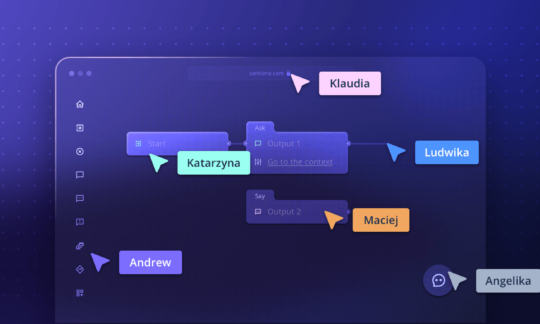Conversational AI Bots vs Rule-Based Chatbots: Pros, Cons & Use Cases
Table of contents
There is no point in denying the ever-increasing influence and market presence of chatbots in business. AI assistants help customers and empower customer service specialists across an uncountable number of industries.
Employing chatbots comes with the colossal upside of enabling savings of up to 30%. That statistic alone can easily turn the unconvinced traditionalist into a budding enthusiast. But a single proportionately high number embedded in a vague promise of profit won’t be enough to sway every stakeholder out there, nor should it. If you’re a business owner, revolutionising the way your cornerstone department performs their day-to-day tasks isn’t a spur-of-the-moment decision. Lots of technical and business questions need a definitive answer first. One of which may concern the type of chatbot to pick: a conversational AI bot, or a rule-based chatbot? Let’s take a deeper look.
Conversational AI vs Rule-Based Chatbots: An Overview
In a grossly oversimplified nutshell, the principal difference between conversational AI and rule-based chatbot comes down to how well they can imitate a human conversation. Conversations with an AI chatbot feel more fluid and natural, whilst rule-based chatbots can come off as robotic or sometimes straight unintelligent. Diligent linguists will be quick to call the distinction between the two misleading, as rules are not just the domain of chatbots – natural, human conversations are also governed by a set of unspoken rules. Nevertheless, as far as conversational bots go, they are a little more nuanced.
Conversational AI bots utilize artificial intelligence, machine learning, and natural language processing to be more accurate, smarter, and able to answer vastly more questions competently. This much higher level of complexity allows them to operate as true virtual assistants and overshadow the capabilities of their rule-based chatbot colleagues in almost every way, but not without some drawbacks that we’ll discuss later.
Companies like SentiOne or Kasisto can provide a great benefit to digital experiences through multilingual AI chatbots. Kasito’s conversational AI platform, KAI, can handle 90% of interactions without involving a human consultant, while SentiOne Automate platform offers 94% of intent recognition accuracy. However, with tech giants like Google with their Dialogflow or IBM with Watson throwing their billion-stuffed hats into the ring, the frontier has not been pushed to its limit yet.
Rule-based chatbots, on the other hand, function based on scripted conversation models. This means their capabilities both in understanding and responding to text prompts are limited mostly to the scope of the script, though they can be programmed to respond to specific keywords. They are quick and easy to set up and deploy and should satisfy a broad spectrum of fairly basic needs, such as tracking orders or listing non-specific information. And you have to give it to them – providers such as Chatfuel boast a 10-times increase in organic sales, on top of many other eye-catching statistics.
Another provider of a rule-based chatbot, ChatPion, has taken things a step further, and gone open source. Chances are you’ve already experienced its capabilities, as ChatPion is fully integrated with Facebook Messenger and Instagram via FlowBuilder, an editor allowing for convenient and fast modifications to the chatbot depending on your needs.
Using Rule-Based Chatbots for Your Business
When deciding on a chatbot solution, it’s important to consider the scope for which you intend to use it. Given that rule-based automation can only offer so much, as a general rule of thumb they will likely find most success when implemented in smaller businesses, websites, and organizations.
Pros of Rule-Based Chatbots
- Cost: implementing a rule-based chatbot will not break the bank, quite the opposite. Some providers, like Manychat, claim that automation can boost revenue generation by a large margin.
- Ease of implementation: Chatbots operating on rules don’t need to be trained on a language model. At the core, they are essentially a flow chart that limits the number of scenarios in the user journey allowing clients to shape the conversations by selecting a specific button, such as “Pricing” or “Opening hours”. Once you set up the ruleset and enable the bot to connect clients with agents, you’re good to go.
- Templates: Companies like ChatPion offer ready-made templates that allow small businesses to customize every little aspect to tailor the chatbot to their needs.
- Time savings: Though the extent to which they can take over customer service or e-commerce aspects of your business is limited, rule-based chatbots still offload a ton of work from human employees, allowing them to focus on addressing more complex tasks.
Cons of Using Rule-Based Chatbots
- Limited use cases: This type of chatbot cannot adapt on the fly and bases its interactability entirely on pre-programmed scripts. Users asking rule-based chatbots questions extending beyond that scope will, to put it bluntly, end up hitting a wall as soon as they veer off-script, with the extra downside of not actually knowing what the chatbot is and isn’t trained to assist with.
- Lack of personalization: As opposed to conversational AI bots, their rule-based counterparts can’t “remember” their interlocutors and track conversations to reference them for later interactions. This makes customers look at chatbots unfavorably.
- Poor fit for larger businesses: Because of the flowchart-like functionality, rule-based chatbot solutions are not able to solve more complex issues, and larger corporations who don’t offer just simple services like parcel tracking may find their customer base hitting the “transfer to agent” button every time, essentially making their customer service bot obsolete.
What Makes Conversational AI Solutions Special
This type of chatbot has one particular leg up over the rule-based variant: intelligence. Relying on Machine Learning and Natural Language Processing enables it to actually understand the user’s prompts and respond dynamically (without the need for a script being preloaded in the background). From the customer’s end, this leads to a more fluid and natural conversation. This, in turn, effectuates a host of other advantages:
AI Customer Support: The Good…
- Multilingual support: One of the key upsides of conversational AI is its ability to respond in virtually any language, assuming it was trained on data sets in that language. Companies like SentiOne allow their customers access to sophisticated conversations with 24/7 support in most European languages and Arabic.
- Advanced customer service: Because machine learning applications for chatbots can achieve so much more, they elevate the quality of support to near-human levels. These virtual assistants rarely sound robotic while offering an overall better experience, since they can process, understand, and assist with more complex issues, making them an ideal solution for a large organization, like a blue chip.
- Greater data protection: Rule-based chatbots are usually deployed on external clouds, but the opposite is true for conversational AI. Keeping everything locked down tight on an internal server or private cloud constitutes additional protection against data theft – a cornerstone issue for the banking or health sector.
- Consistent responses: Entity recognition allows chatbots using AI to remember the context of the conversation, easily remember the client’s previous questions or concerns, and reference them anytime.
…And the Not-So-Good:
- Longer setup: The time needed to properly implement conversational AI is much, much greater in comparison to rule-based chat assistants. Properly setting up an AI platform like that typically has to involve loads of different team members, like the IT team, DevOps, and testers, just to name a few.
- Resource intensive: To make the chatbot resemble the human experience and utilize the power of NLP to the fullest, large amounts of resources are needed to teach the AI how to respond to every situation. This involves greatly increased costs spent getting the chatbot off the ground, way before it can start helping customers directly.
- Customer apprehension: No matter how sophisticated our AI companion may be, some customers simply won’t be open to talking to a machine. And while that number may be gradually decreasing with 62% of customers preferring to chat with a chatbot rather than wait for a human, AI companies like ours still have their work cut out for them to warm up the image of conversational artificial intelligence.
Use Cases for Conversational AI and Rule-Based Chatbots
The choice of automation best suited for a business will depend on several factors. As established, larger businesses wanting to implement chat AI solutions can reap much greater benefits from conversational AI due to its higher levels of sophistication. To use a previous example, organizations in the healthcare sector would choose conversational AI over a rule-based chatbot when seeking a solution to simplify processes like patient registration or booking appointments, or perhaps even creating a medical virtual assistant to allow patients to check their symptoms.
On the other hand, rule-based chatbots can offer more basic levels of support to smaller enterprises. When properly programmed, the chatbot can answer frequently asked questions, track orders, give updates, and perform routine tasks that would normally drain the time of human agents. Combine that with their lower overheads and the availability of highly customizable templates and you end up with a solution like Tidio, which automates a large portion of customer inquiries.
Conclusion
It’s important to remember that no chatbot, regardless of the technology it’s based on, can be the definitive solution for any business out there. Before committing to a choice, you should strongly consider the pros and cons listed above in the context of the needs of both your business and customers and the goals that you want to achieve. Take all those factors into account, weigh them against the implementation and maintenance cost of the chatbot, and you should come away with a pretty good idea of what solution is likely to be best for you.
Elevate Your Customer Service with SentiOne
As mentioned before, our NLU and NLP-based chatbot solutions boast an extremely high intent accuracy recognition of up to 96%. Want to transform the quality of your customer service? Find out more about our conversational AI platform, book a demo to discuss your specific needs with us, or try our ROI calculator to see exactly how much SentiOne can do for you.
Article Summary
Chatbots are gaining popularity in business, providing cost savings and improved customer service. There are two main types: conversational AI bots and rule-based chatbots. Conversational AI bots, ideal for enterprises like the banking and finance industry, use artificial intelligence and natural language processing to offer accurate and intelligent responses. They function as virtual assistants and handle a wide range of questions. Rule-based chatbots rely on pre-programmed scripts and are limited in their capabilities. However, they are ideal for smaller businesses with basic needs. Conversational AI bots offer intelligence and superior customer experience, but require more resources and setup time. The choice between the two depends on the specific needs and goals of the business.



